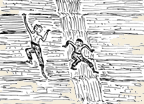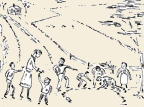
Summer 2002

 |
|
 |
| Home | Index | Museums | Blog | Authors | Site Map | About |
|
Rememberingthe New York CentralbyRichard PalmerPart IPart IIThe late 1940s and the 1950s saw change creep into the industry. Up to the time I was about 12 or 13 years old, the colorful steam locomotives were being replaced by diesels which at the time we called "growlers." Compared with the majestic Hudsons, Niagaras and Pacifics, their successors were more cost effective and efficient, but certainly not as interesting. Steam locomotives had a personality that no diesel could ever match, and their passage was not without regret, especially since the cost-conscious but short-sighted railroad management failed to save one or two examples for future generations to wonder at. Every last one of them was scrapped. Otherwise, the New York Central bowed to modern times in 1949 when the six-day work week was abolished in favor of a five-day, 40-hour week, at least for the non-operating people. A long hiring freeze ensued in order to eliminate the telegraph operators and station agents through attrition and retirement. By the early 1950s, telegraphers, agents and towermen were a vanishing breed. Replacements were hired only out of dire necessity. The old timers I remember ranged from the small, frail and white-haired agent to the loud, boisterous, cigar-smoking icons who were left-overs from the age of steam. There had always been an "extras" board, a list of men available in the different crafts that could be called upon. When railroad business was slow, some lower on the seniority list who had been laid off or "furloughed," were put on the extra list. There was also a term called "bumping" which means that a railroader who had more years than someone else could bid on a job then being held by someone with fewer years of seniority. It all had to do with the parochialism of union agreements. I had a cousin much older than myself who finally had his dream come true of hiring out on the railroad. Fortunately, by that time, the requirement that telegraphy must be mastered was only a memory. Yet some of the old "operators" looked down their noses at the new generation who could telephone but not telegraph. "Well, maybe you'll learn enough of it to get by" was often the compromise. The signal towers spread down the line from Syracuse to Buffalo had been built in the 1920s or before, and their accommodations were fairly ancient by more modern standards. Each tower's heating system had its own quirks, likes and dislikes. The bottom of the tower housed a furnace, and those that used hard coal were the better ones. On a cold winter evening there was no more soul-satisfying sound than to hear the hiss of the valve in the radiators as small jets of steam popped out occasionally. To maintain this warmth, the operator had to make periodic trips out the door, down two flights of stairs and enter the boiler room to feed the furnace. A radiator that was cooling off signaled its intentions by a pounding or hammering sound. To ignore this meant problems. It was nearly unforgivable to leave after an eight-hour trick without having "fixed the fire" for the next man. It didn't take too long to learn the workings of each furnace. Several of the towers had furnaces fired by soft coal. Whoever designed and approved soft-coal heating systems must have had many a laugh as he thought of the operators trying to keep a warm fire. Soft coal seemed to perform best on a warm April or May evening. Trips down to see how the soft coal fire was doing were much more frequent than for anthracite burners. More than once an operator said, "I might as well have been a fireman on a steam engine." Upon opening the firebox door there was the dreaded sight of a layer of coal just lying there, the yellowish-green smoke pouring up the chimney. The only thing to do was to take a long four-to-six-foot-long poker and punch a hole in the coal so it would burn instead of smoke. Giving a cautious jab into the bed of coal resulted in the smoke igniting with a "whoosh" not unlike igniting gasoline. Then, with a little skill acquired in stoking temperamental coal furnaces, the operator got the fire to burn evenly for awhile. The towerman usually tried to pick a time to go down and tend the fire when no train was near and when his immediate presence by the phone wasn't required. Centralized traffic control has made signal towers and their operators obsolete. When first developed, remote controls for the New York Central were located in Buffalo, Rochester, Utica and Albany. Today CSX operates its signal control system out of Jacksonville, Florida. Part I© 2002, Richard F. PalmerIndex to articles by Richard F. PalmerCLR Blog | Site Map | Contact CLR |